
Cervelas de Lyon is a sausage that is among the specialties of Lyonnaise cuisine.
Contents
The sausage contains finely minced pork and either truffles or pistachios. Sold uncooked, the sausage has to be boiled before it is eaten. [1] [2] [3] [4]

Cervelas de Lyon is a sausage that is among the specialties of Lyonnaise cuisine.
The sausage contains finely minced pork and either truffles or pistachios. Sold uncooked, the sausage has to be boiled before it is eaten. [1] [2] [3] [4]
There are many varieties of Lyon sausages that have come of age with recipes handed down by the ancestors of the pork butchers from the city of the Gauls. Among these, some are dry, both small and large, called the rosette or Jésus. [5]
The local sausages of Lyon are, however, made to be cooked. One of the sausages, the cervelas, is produced short and fat with prime pork stuffing with either pistachios or truffles. It derives its name from brains, since it was initially made from pork brains. On the other hand, the sabodet, with its coarser texture, comes from Isère and is made from pork head, rind, and meat. [5]

Cajun cuisine is a subset of Louisiana cooking developed by the Cajuns, itself a Louisianan development incorporating elements of Native American, West African, French, and Spanish cuisine.

French cuisine is the cooking traditions and practices from France. In the 14th century, Guillaume Tirel, a court chef known as "Taillevent", wrote Le Viandier, one of the earliest recipe collections of medieval France. In the 17th century, chefs François Pierre La Varenne and Marie-Antoine Carême spearheaded movements that shifted French cooking away from its foreign influences and developed France's own indigenous style.

A sausage is a type of meat product usually made from ground meat—often pork, beef, or poultry—along with salt, spices and other flavourings. Other ingredients, such as grains or breadcrumbs, may be included as fillers or extenders.

Botifarra is a type of sausage and one of the most important dishes of the Catalan cuisine.

Louisiana Creole cuisine is a style of cooking originating in Louisiana, United States, which blends West African, French, Spanish, and Native American influences, as well as influences from the general cuisine of the Southern United States.
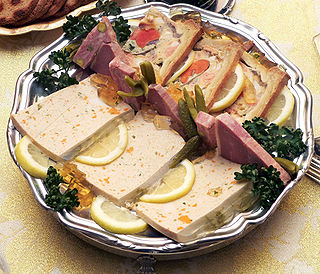
Offal, also called variety meats, pluck or organ meats, is the internal organs of a butchered animal. The word does not refer to a particular list of edible organs, and these lists of organs vary with culture and region, but usually exclude skeletal muscle. Offal may also refer to the by-products of milled grains, such as corn or wheat.

A saveloy is a type of highly seasoned sausage, usually bright red, normally boiled and available in fish and chip shops around Britain. It is sometimes also available fried in batter.

Cervelat, also cervelas, servelat or zervelat, is a sausage produced in Switzerland, France, Belgium, the Netherlands and parts of Germany. The recipe and preparation of the sausage vary regionally.
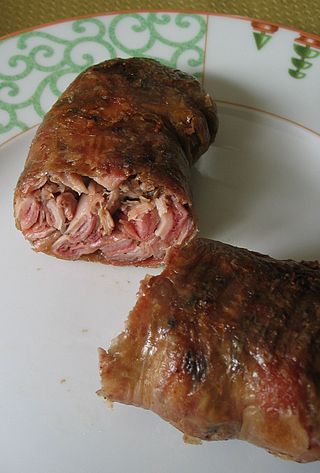
Andouillette is a French coarse-grained sausage made from the intestine of pork, pepper, wine, onions, and seasonings.
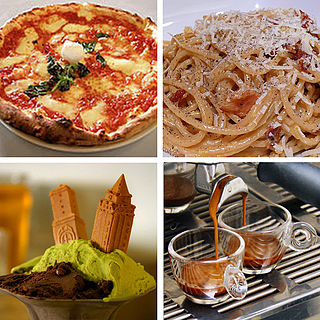
Italian cuisine is a Mediterranean cuisine consisting of the ingredients, recipes, and cooking techniques developed in Italy since Roman times, and later spread around the world together with waves of Italian diaspora. Significant changes occurred with the colonization of the Americas and the introduction of potatoes, tomatoes, capsicums, maize, and sugar beet—the latter introduced in quantity in the 18th century. It is one of the best-known and most widely appreciated gastronomies worldwide.

A bouchon is a type of restaurant found in Lyon, France, that serves traditional Lyonnaise cuisine, such as sausages, coq-au-vin, "salade lyonnaise" duck pâté or roast pork. Compared to other forms of French cooking such as nouvelle cuisine, the dishes are quite hearty. There are approximately twenty officially certified traditional bouchons, but a larger number of establishments describe themselves using the term.

Chocolate salami is an Italian and Portuguese dessert made from cocoa, broken biscuits, butter and sometimes alcohol such as port wine or rum. The dessert became popular across Europe and elsewhere, often losing alcohol as an ingredient along the way.
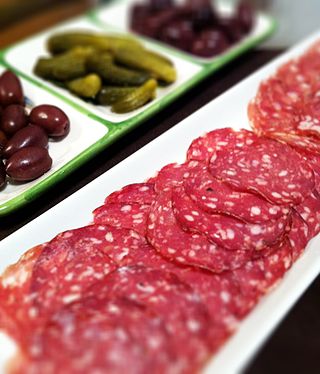
Rosette de Lyon is a cured saucisson from France. It is made from pork and usually served thinly sliced.
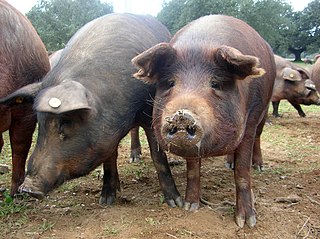
Extremadura, Spain is known for its different ways of preparing the Iberian pork and mutton. The main characteristics of the traditional Extremaduran cuisine are its simplicity, its lack of clutter and its low cost. It is also a cuisine reflecting a generous spirit, for many of its preparations used to be cooked in large pots to share with visitors, friends, and neighbors. The resulting dishes are eaten with local bread.

Venetian cuisine, from the city of Venice, Italy, or more widely from the region of Veneto, has a centuries-long history and differs significantly from other cuisines of northern Italy, and of neighbouring Austria and of Slavic countries, despite sharing some commonalities.
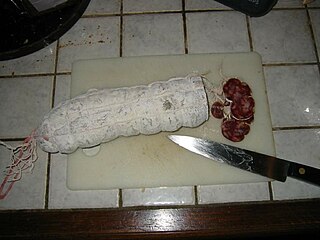
Saucisson, also saucisson sec or saucisse sèche, is a family of thick, dry-cured sausage-shaped charcuterie in French cuisine. Typically made of pork, or a mixture of pork and other meats, saucisson are a type of charcuterie similar to salami.

Lyonnaise cuisine refers to cooking traditions and practices centering on the area around the French city of Lyon and historical Lyonnais culinary traditions.

Kielbasa is any type of meat sausage from Poland and a staple of Polish cuisine. It is also known in other world cuisines; in American English, the word typically refers to a coarse, U-shaped smoked sausage of any kind of meat, which closely resembles the Wiejskasausage.

Mère is an honorary title given to talented female professional cooks, many of whom had no formal training, in France during the 18th, 19th, and 20th centuries. Between 1759 and the end of the 20th century multiple women have been called Mère. Their work turned the city of Lyon and its environs into the gastronomic center of France and the world, and the most famous of them, Mère Brazier, is regarded as "the mother of modern French cooking".